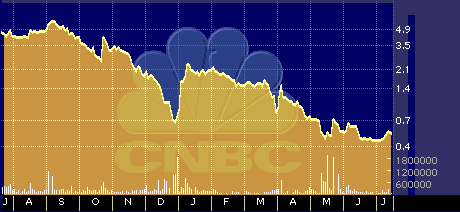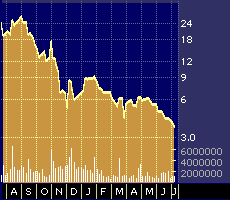
To Be or Not to Be?
To Be or Not to Be?
by Hal Plotkin
Silicon Valley Correspondent
Although some industry watchers are skeptical, one analyst says demand for Be Inc.’s {BEOS} computer operating system will help drive the company’s stock price up more than 100 percent over the next 12 months.
“I’m quite optimistic that when computer users find out how hard it is to manage audio and video using [Microsoft’s] Windows, they’ll clamor for the Be operating system, and computer manufacturers will give it to them,” says Charles H. Finnie, an analyst at Volpe Brown Whelan & Co., based in San Francisco.
Finnie is quick to add that he doesn’t expect Be’s operating system will supplant or replace Windows. “But it will reside side-by-side with Windows,” he says. “It does a much better job of handling audio and video.”
Finnie, whose company helped manage the July 20 initial public offering for Be, released a research report on Aug. 24 in which he rates Menlo Park, Calif.-based Be “strong buy.”
Recently, the stock has been changing hands close to its original $6 offering price after falling back from its high of $10.94. Finnie has set a 12-month price target of $16 for the stock. “We believe that Be will sign a major PC [original equipment manufacturer] during the second half of 1999,” Finnie wrote in the report.

BEOS stock performance since its IPO
Be, founded in 1990 by former Apple Computer Inc. {AAPL} executive Jean-Louis Gassée, makes a computer operating system that’s optimized for audio and video applications. Target customers are makers of low-cost PCs and next-generation Internet appliances. Consumers can also purchase the product.
So far, sales of Be’s operating system have been slim. Although the software has been in development for about nine years fewer than 80 units of Be’s operating system — representing sales of just $3,861 — were made directly to end-user customers during June, according to PC Data, a market-research firm based in Reston, Va. PC Data’s figures don’t include sales made through Be’s Web site, a figure the company declined to disclosed. Be ranks 11th on PC Data’s list of 12 operating-system vendors.
The results of PC Data’s survey of operating-system sales through the OEM and value added reseller distribution channels, which Be is targeting, are even less impressive. “They don’t show up in that category at all yet,” says Roger Lanctot, PC Data’s director of research. “But the fact we register any direct sales at all is reassuring.”
Be currently has deals with several manufacturers, including Hitachi, Fujitsu, and low-cost PC-sellers iDot, Microworkz, and AST Computers, which is expected to bring new Be-powered products to market. Intel Corp. {INTC} holds a minority stake in the company.
Finnie says Be’s growth spurt will kick in next year, when he projects sales of $15.7 million, growing to nearly $70 million the following year, with anticipated 2001 earnings of four cents per share.
For the second quarter, ended June 30, Be posted revenue of $537,000, mostly representing licensing deals, up from $309,000 in the first quarter. The company’s loss for the second quarter was $4.7 million, or $1.11 a share, as compared with a loss of $4.5 million, or $1.47 a share, for the same period in 1998.
Stacy Quandt, an analyst at Giga Information Group in San Jose, Calif., says Be is facing an increasingly competitive environment. “The real problem for the company right now is it’s hard for them to get momentum when there is so much hype for Linux,” she says. Linux is the free open-source operating system sold, with documentation and support, by companies such as Red Hat Inc. {RHAT} and Caldera Systems. “Even if you have a low price, it’s hard to compete with something that’s free,” she adds.

RHAT stock performance since its IPO
For example, Quandt notes, the Wherehouse music store chain, based in Torrance, Calif., is about to roll out Linux-powered kiosks that allow customers to preview music samples. “There is a real trend toward using Linux in digital media applications,” she says.
James Smith, an analyst at Dataquest, based in San Jose, Calif., agrees. “Linux is going to be a major competitor in that market,” he says.
Both Quandt and Smith say Linux’s current high profile may help make it the operating system of choice for many new Internet appliances.
Current sales of Internet-linked appliances are mostly limited to devices such as the Palm Pilot. But many analysts say an avalanche of new Net-connected devices will hit the market beginning next year. Overall, the market for Internet appliances is projected to grow to 55.7 million units in 2002, up from 5.9 million last year, according to International Data Corp., based in Framingham, Mass.
The question is whether Be, Inc. will succeed in grabbing a slice of that growing market.
The company may have a chance, says Chris Le Tocq, director of software consulting at Dataquest. “I used to say the [operating-system] market was like a game of musical chairs and that Be didn’t have a seat. Now, more chairs are being placed in the game, but there is still a lot of competition for those chairs,” he says.
“It’s not too late for Be,” Lanctot says. “There’s still a great opportunity out there.”


